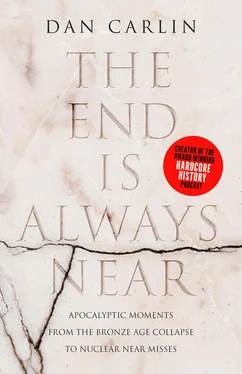What had Assyria done to deserve such a fate?
In the scope of human history, there are two kinds of cultures that have had a large geopolitical impact on the historical stage. The first are the societies and cultures that can trace their lineage back to much earlier versions of themselves, like the Chinese and Egyptian civilizations. They’ve had their high points and low points, but they’ve always been a political force to reckon with through thousands of years of history, and they’re still here. Perennial players.
The second are societies that seem to have had a glory-filled golden era, then fell into obscurity. Their historical moment in the sun, so to speak. The Mongol people are one example. Today, the Mongols are on the periphery of world events, a seemingly poor and out-of-the-way and behind-the-times culture, at least compared with what we call the “developed world.” But the Mongol people at one time ruled most of the known world and did so for several hundred years. This may have seemed like a long stretch at the time, but it was a blink of an eye compared with the ancient Assyrians.
The great state of Babylonia, to the south of Assyria, was the empire’s great adversary throughout their Bronze and Iron Age histories. Babylonia’s capital city, Babylon, located some fifty-five miles south of modern Baghdad, was one of the greatest cities ever built. It was likely the first metropolis inhabited by more than two hundred thousand people, and at its height had maybe twice that many. Remarkably, in this era before modern sanitation and modern medicine and with so many people living in such close proximity, Babylon managed to stay largely plague-free. (Babylon would outlive its great Assyrian rival to the north and would eventually seem like an urban refuge from a previous age in the new world to come.)
Some two hundred years after Assyria’s fall, a Greek general named Xenophon recorded an encounter with what was left of Assyria’s grandeur when he saw cities—places that were larger and more formidable than anything he’d seen back in Greece—dissolved into ruins. Xenophon wrote the Anabasis —now considered a classic of Western literature—about his experience commanding Greek mercenaries in a Persian civil war. As Xenophon and ten thousand Greeks fought a running battle trying to escape from their pursuers after fighting on the losing side of that war, they stumbled upon enormous fortifications and cities decomposing in the sand in what’s now northern Iraq—the ruins of something greater than his own civilization had ever produced. Almost 2,500 years ago Xenophon wrote, “The Greeks marched on safely for the rest of the day and reached the River Tigris. There was a large deserted city there called Larissa, which in the old days used to be inhabited by the Medes. It had walls twenty-five feet broad and one hundred feet high, with a perimeter of six miles. It was built of bricks made of clay, with a stone base of twenty feet underneath.”
Later, they came upon yet another city.
From here, a day’s march of eighteen miles brought them to a large undefended fortification near a city called Mespila … The base of the fortification was made of polished stone, in which there were many shells. It was fifty feet broad and fifty feet high. On top of it was built a brick wall fifty feet in breadth and a hundred feet high. The perimeter of the fortification was eighteen miles.
These cities were gargantuan by Greek standards, and Xenophon asked the locals about them; they said the structures had been built by the Medes, because that’s who’d preceded the Persian Empire they were then living under. But in fact these weren’t Median cities, they were Assyrian. The one “near a city called Mespila” is thought to have been Nineveh—Xenophon was marveling at its majestic remains two hundred years after its demise.
Xenophon was someone whom we today would think of as inhabiting the old world. Ancient Greece is, after all, a very early European civilization. But he was looking at something that was already ancient in his day—the equivalent of a Statue of Liberty in the sand from a Near Eastern empire that had been the superpower of its age a mere two centuries previously, and one that now seemed so thoroughly erased that the locals didn’t even know to whom it had belonged. [1]
Before its fall, the Mesopotamian culture that Assyria was a part of was akin to Civilization 1.0. Babylon and Assyria represented the apex of that civilization’s version, with a growth in power, sophistication, and development that had begun in places like Ur, Akkad, and Sumeria. This basically unbroken civilizational tree lasted longer than any of the versions since. By way of comparison, if we were to date our modern civilization to the beginning of the Renaissance, we could count it as so far lasting around five or six hundred years. Assyria and its world was three to five times older than that, depending on how you date it, but their own records show an unbroken line of kings dating all the way back to the 2300s BCE, [2]and Nineveh, their greatest city, fell around 600 BCE. That’s nearly two millennia that these people were a recognizable regional entity. The oldest work in European literature is often credited to Homer and dated between 800 and 1000 BCE—compare that with The Epic of Gilgamesh , from Mesopotamia, which was put into writing in about 2100 BCE and had been an oral story earlier than that. Civilization 1.0 had deep roots.
It’s difficult to understand just how urban this culture was, and how much in some ways it reminds us of our own modern society. If you were to look at a map of the Mediterranean and west Asia in the Bronze and Iron Ages, it would look a lot like a map of early twentieth-century, pre–First World War Europe. There were several powerful states intertwined with one another through diplomacy and alliances. When they went to war, they often went as coalitions, as the Triple Entente and the Central Powers did in the First World War, and the Allied and Axis powers did in the Second.
To continue the analogy, the Assyrians would be the Germans, because the Germans have always had a reputation for being militarily tough, not just in the twentieth century, but throughout history. An oft-cited rationale proposed for this is that the area of modern Germany is surrounded by other powerful peoples and doesn’t have a lot of natural frontiers, making it difficult to defend. From a social Darwinian perspective, you might say the only people who could survive in an area like that would be those who were tough and warlike. The same is often said about the Assyrians, because ancient Assyria was also ringed by powerful states and suffered a lack of natural frontiers, so the Assyrians had to be very tough, very centralized, very efficient, and very good warriors to survive.
As with the citizens of most powerful states throughout the ages, though, it is highly unlikely that the citizens of ancient Nineveh ever thought their culture would be wiped off the map.
But the fall of Nineveh is probably one of the most significant geopolitical events in world history. It is certainly the geopolitical event of the Near East Iron Age. It’s like the fall of Berlin in the Second World War in that it forever and decisively ended an empire, but the destruction of Nazi Germany toppled a twelve-year regime while Assyria’s fall meant the end of an ancient power. And the Assyrians were often cast, especially by their neighbors, as the equivalent of the Nazis in the biblical era. [3]
Конец ознакомительного фрагмента.
Текст предоставлен ООО «ЛитРес».
Прочитайте эту книгу целиком, на ЛитРес.
Читать дальше











